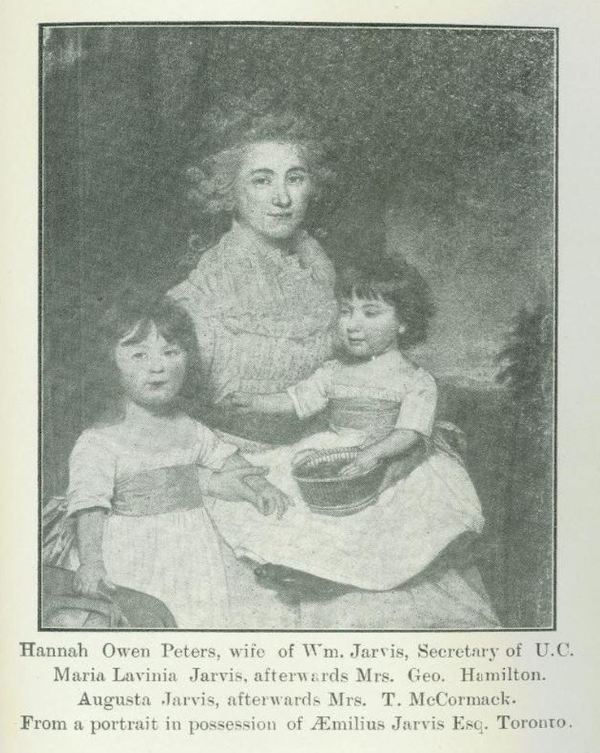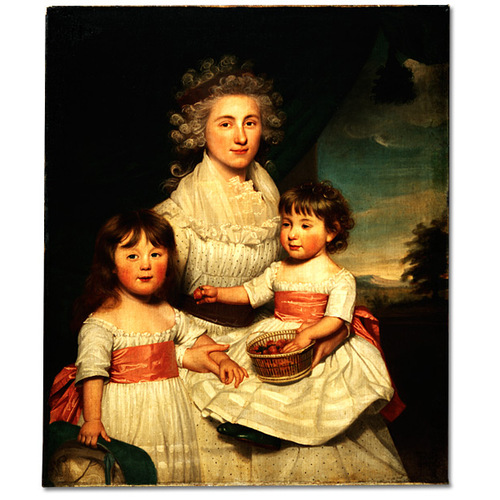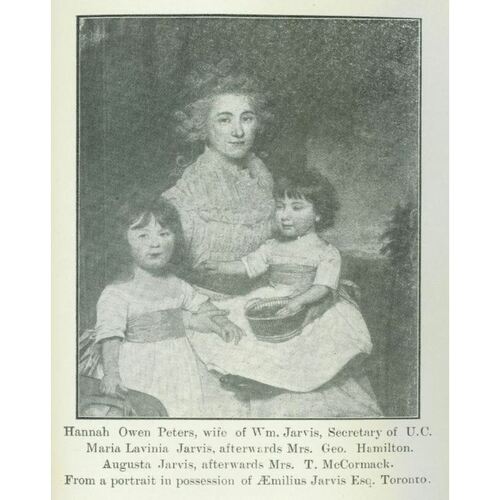
Source: Link
PETERS, HANNAH (Jarvis), gentlewoman and author; b. 2 Jan. 1763 in Hebron (Marlborough), Conn., only surviving child of the Reverend Samuel Andrew Peters and his first wife, Hannah Owen; m. 12 Dec. 1785 William Jarvis* in London, and they had seven children; d. 20 Sept. 1845 in Queenston, Upper Canada.
Hannah Peters’s father was the Church of England minister in Hebron; her mother died when she was two. Hannah was sent to school in Boston, where she remained when her father’s strong tory views forced him to flee to England in 1774. She later joined him in Pimlico, then an undeveloped suburb of London; he claimed that she had been educated “in England, France and Germany.” After her marriage to William Jarvis, another loyalist exile, the young couple lived with Peters in Pimlico, where their three eldest children were born. On John Graves Simcoe*’s recommendation, Jarvis was appointed provincial secretary and registrar of Upper Canada, and in April 1792 the Jarvis family sailed for Canada. Her husband reported that “Mrs. Jarvis leaves England in great spirits.”
After a stormy voyage on which Hannah Jarvis showed “invincible courage,” and a short time in Kingston, the family arrived in Newark (Niagara-on-the-Lake) in September 1792. Jarvis bought a log hut and immediately began to build an addition, a matter of some urgency because his wife was pregnant. “I make no doubt I shall do very well,” she wrote when her only son, aged five, died of diphtheria; Samuel Peters Jarvis* was born less than a month later. Two more children were born in Newark, and another after the family moved to the new capital, York (Toronto), in 1798.
Society there was small and insular, but still had dissension within it between those from Britain and those from the United States. Both Hannah Jarvis and Anne Powell [Murray] deeply resented the bias against the Americans, including loyalists, shown by the British families. From the first, Hannah detested “the old Rogue” (Peter Russell*) and “the little stuttering Vixon” (Elizabeth Posthuma Simcoe [Gwillim]). She hated Mrs Simcoe for her wealth, and what she thought was parsimony, conceit, selfishness, and undue influence, especially over Lieutenant Governor Simcoe. “Money is a god many worship.” Robert Hamilton* and his family were the Jarvises’ closest friends.
Samuel Peters’s first letter to his daughter in Upper Canada urged the couple to live in harmony with all men, and with economy, but unhappily they did neither. Amid acrimonious wrangling, Jarvis lost much of his income in 1795 when the fees on land patents were redistributed among colonial officials. Like Mrs Simcoe and Mrs Powell (but with less justification) Hannah Jarvis had utter confidence in her husband’s ability, so much so that she regarded those who criticized or harassed him as bitter enemies. Worse than Hannah’s vehement partisanship, however, was the Jarvises’ total inability to practise economy. Even before they moved to York, they were noted for ostentation and “unbounded extravagance.” Attempts at retrenchment were made; in 1801, for example, Hannah Jarvis wrote, “I have turned tailoress for my family, not even the Secretary excepted.” Such efforts were not enough, nor did the grant of £1,000 in 1815 as compensation for Jarvis’s earlier loss of fees solve their financial difficulties. Finally, in October 1816, Jarvis, with his wife’s consent, transferred all his property and debts to his son, Samuel Peters Jarvis.
William Jarvis died less than a year later. Stoically his wife attended his funeral alone; Samuel was in jail charged with murder in a fatal duel, and her other children did not receive word in time. Hannah Jarvis was now completely dependent upon her son, except for a government pension of $100 a year and her loyalist grant of 1,200 acres of wild lands which produced taxes but no income. For a time she remained in her old home, now belonging to Samuel, but in May 1819 she left York to spend the rest of her life in lengthy visits to her daughters in Hamilton, Niagara, Queenston, and Newmarket. She received the rent of the house in York for several years, and was thus able to send some money to her father, now living in penury in New York. In 1825, when Samuel as his father’s heir received £1,000 further compensation for lost fees and was building himself a large house, he sold 400 acres of his mother’s land, with her consent, to pay his builder.
By the 1830s Hannah Jarvis was living most of the time with her daughter Hannah Owen (the wife of Alexander Hamilton) in Queenston, helping her cope with a big house and frequent pregnancies. She was there in 1839 when Hamilton died, leaving his pregnant wife and nine children penniless. “You are all God’s children now,” Hamilton said. The household’s sole income was Hannah Jarvis’s tiny pension. Hannah Hamilton took in sewing, earning 2s. 6d. a shirt, while her mother, now in her late 70s, looked after the house and young children, assisted by her older granddaughters, and did all the work in the poultry yard and vegetable garden except the spring digging. Hannah Jarvis, who had once had eight servants and slaves, now spent her days washing, ironing, scrubbing, cleaning, mending, and cooking. She who had once owned the first carriage in Upper Canada now travelled in a borrowed lumber wagon. “Strangers have . . . come foreward and placed coverings on their Backs.” There was often no money in the house, and sometimes no food.
Throughout it all, “the Old Lady,” as her grandchildren called her, maintained her customary energy, fortitude, and cheerfulness. In 1815 a niece had described her as “the most active Woman that I ever saw . . . it is surprising to see her fly about the House as she does”; in her old age she was “as active as ever.” Close to death from an incurable stomach tumour, she dreamt of thieves among the turkeys – and finished knitting garters for the entire Hamilton brood.
In her early days, Hannah Jarvis wrote long letters to her father and her half-brother, William Birdseye Peters*, with detailed descriptions of her life in the upper echelons of society, as well as bitter invective against those she disliked. In her declining years she kept a diary notable for its pathetic record of toil and hardship. Many Upper Canadians, of course, spent their entire lives in such drudgery, but Hannah Jarvis was a gentlewoman in a classed society. Through the imprudence of her husband and son-in-law, and the insensibility of her son, she became almost destitute. It was Hannah Jarvis’s misfortune that she had more energy and sense of responsibility than any of the men whose duty it was to protect her.
Some of Hannah and William Jarvis’s correspondence has been published as “Letters from the secretary of Upper Canada and Mrs. Jarvis, to her father, the Rev. Samuel Peters, D.D.,” ed. A. H. Young, Women’s Canadian Hist. Soc. of Toronto, Trans., no.23 (1922–23): 11–63.
AO, MS 787; MU 2316. MTRL, [E. Æ. Jarvis], “History of the Jarvis family” (typescript, [190?]); S. P. Jarvis papers; William Jarvis papers. PAC, MG 23, HI, 3. Univ. of Guelph Library, Arch. and Special Coll. (Guelph, Ont.), J. MacI. Duff coll., Samuel Peters papers. Samuel Peters, “‘Bishop’ Peters,” ed. A. H. Young, OH, 27 (1931): 583–623; A history of the Rev. Hugh Peters, A.M. . . . (New York, 1807). Town of York, 1792–1815 (Firth). York, Upper Canada: minutes of town meetings and lists of inhabitants, 1797–1823, ed. Christine Mosser (Toronto, 1984). The Jarvis family; or, the descendants of the first settlers of the name in Massachusetts and Long Island, and those who have more recently settled in other parts of the United States and British America, comp. G. A. Jarvis et al. (Hartford, Conn., 1879). W. B. Sprague, Annals of the American pulpit . . . (9v., New York, 1857–59). A. S. Thompson, Jarvis Street: a story of triumph and tragedy (Toronto, 1980).
Cite This Article
Edith G. Firth, “PETERS, HANNAH (Jarvis),” in Dictionary of Canadian Biography, vol. 7, University of Toronto/Université Laval, 2003–, accessed December 31, 2025, https://www.biographi.ca/en/bio/peters_hannah_7E.html.
The citation above shows the format for footnotes and endnotes according to the Chicago manual of style (16th edition). Information to be used in other citation formats:
| Permalink: | https://www.biographi.ca/en/bio/peters_hannah_7E.html |
| Author of Article: | Edith G. Firth |
| Title of Article: | PETERS, HANNAH (Jarvis) |
| Publication Name: | Dictionary of Canadian Biography, vol. 7 |
| Publisher: | University of Toronto/Université Laval |
| Year of publication: | 1988 |
| Year of revision: | 1988 |
| Access Date: | December 31, 2025 |




